
Minnesota is home to one of the deepest lakes in the world, in addition to many other lakes with significant depths. These enchanting lakes reside primarily in the state’s northern reaches and are surrounded by lush vegetation. As the land of 10,000 lakes, Minnesota is well-known for its adamant and rich lake population. This article will uncover ten of the deepest lakes in Minnesota. There are so many lakes, so it’s not feasible to claim any as the top ten deepest. However, they are considered some of the deepest by experts.
Furthermore, from the grandeur of Lake Superior to the charm of smaller lakes, these water bodies are rich in diversity, ecosystems, and recreational opportunities for all interests and skill levels. Let’s explore ten of the deepest lakes in Minnesota in order of the deepest.
Lake Superior

With a maximum depth of 1,332 feet, Lake Superior is the deepest lake in Minnesota by a landslide.
©Elena Elisseeva/Shutterstock.com
Lake Superior is the largest of the Great Lakes by volume and depth. It is also the deepest lake in Minnesota. It is a colossal body of water in the northeastern section of Minnesota. According to the United States Environmental Protection Agency, it boasts a monumental maximum depth of 1,332 feet, making it the deepest lake in the state by a landslide. This magnificent lake is situated approximately 155 miles north and slightly east of Minneapolis, making it a prominent geographical feature of the region.
Furthermore, covering a vast surface area of 31,700 square miles, Lake Superior extends its arms across the borders of Minnesota, Michigan, Wisconsin, and the Canadian province of Ontario. It stretches approximately 350 miles in length and 160 miles in width.
Moreover, Lake Superior itself and the surrounding landscapes are home to striking natural beauty. It is a popular lake for recreation and is home to many species. Its rugged shoreline consists of cliffs, rocky beaches, and expansive forests. The lake’s clear waters offer opportunities for cold-water swimming, boating of all kinds, fishing, and more. Moreover, it is a vital transportation route for shipping, connecting Minnesota to the broader Great Lakes system and even the Atlantic Ocean.
The lake is home to many species of fish. Some more well-known species include brown trout, rainbow trout, lake whitefish, muskellunge, northern pike, smallmouth bass, walleye, Atlantic salmon, Chinook salmon, coho salmon, carp, and much more.
During the frigid winter months, Lake Superior develops unique ice caves. The lake’s shoreline transforms into a mesmerizing landscape of frozen formations due to the massive wave activity creating frozen layers of ice on land along the shoreline. It is a mesmerizing spectacle.
Lake Saganaga
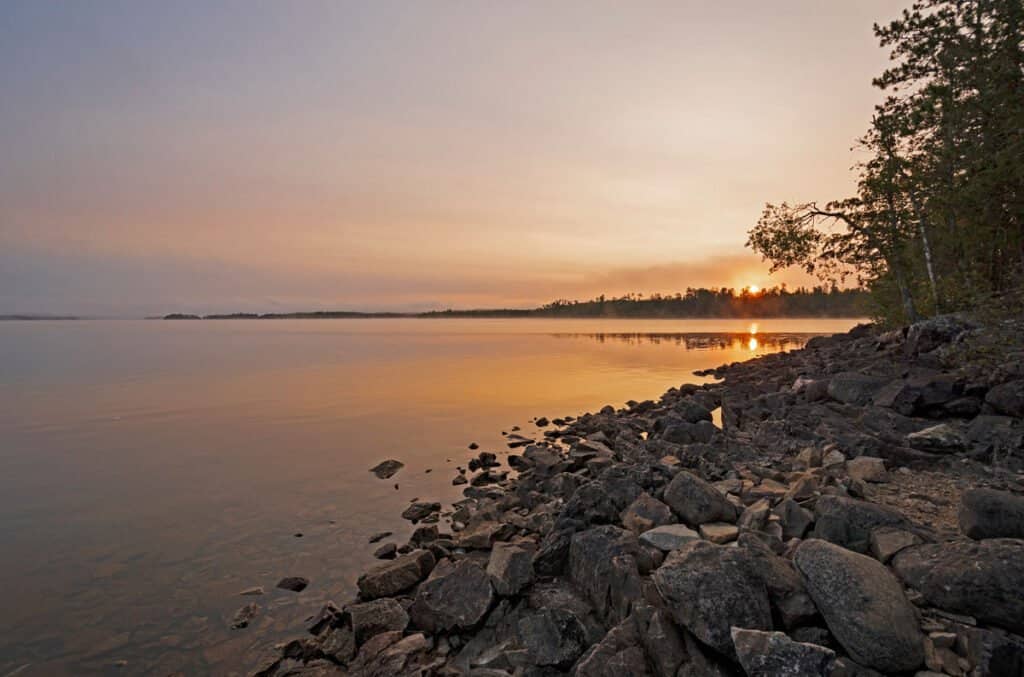
270 miles northeast of Minneapolis, Lake Saganaga has an impressive maximum depth of 280 feet.
©Wildnerdpix/Shutterstock.com
Lake Saganaga is a hidden treasure in the northern reaches of Minnesota on the Canadian border. Its maximum depth reaches approximately 280 feet. This remote lake is located around 270 miles northeast of Minneapolis as the crow flies, offering a serene escape into the heart of the wilderness.
Furthermore, with a surface area of roughly 13,832 acres, Lake Saganaga boasts a meandering shore length that stretches for about 277 miles. Its shape and scenic islands create a captivating landscape. The lake is known for its clear waters and is a paradise for paddlers, offering excellent canoeing and kayaking opportunities.
Moreover, Lake Saganaga is a popular destination for anglers, with a variety of fish species, including walleye, northern pike, lake trout, and smallmouth bass, amongst many others. Its deep waters hold the promise of a rewarding fishing experience.
One of the unique features of Lake Saganaga is its location within the Boundary Waters Canoe Area Wilderness (BWCAW) and Quetico Park. This wilderness area encompasses over a million acres of pristine forests, lakes, and rivers, making it a sanctuary for nature lovers and outdoor adventurers.
In the winter, the lake and surrounding wilderness become a playground for snowmobilers, hunters, cross-country skiers, and ice fishermen, further showcasing the versatility of this natural wonder.
La Salle Lake
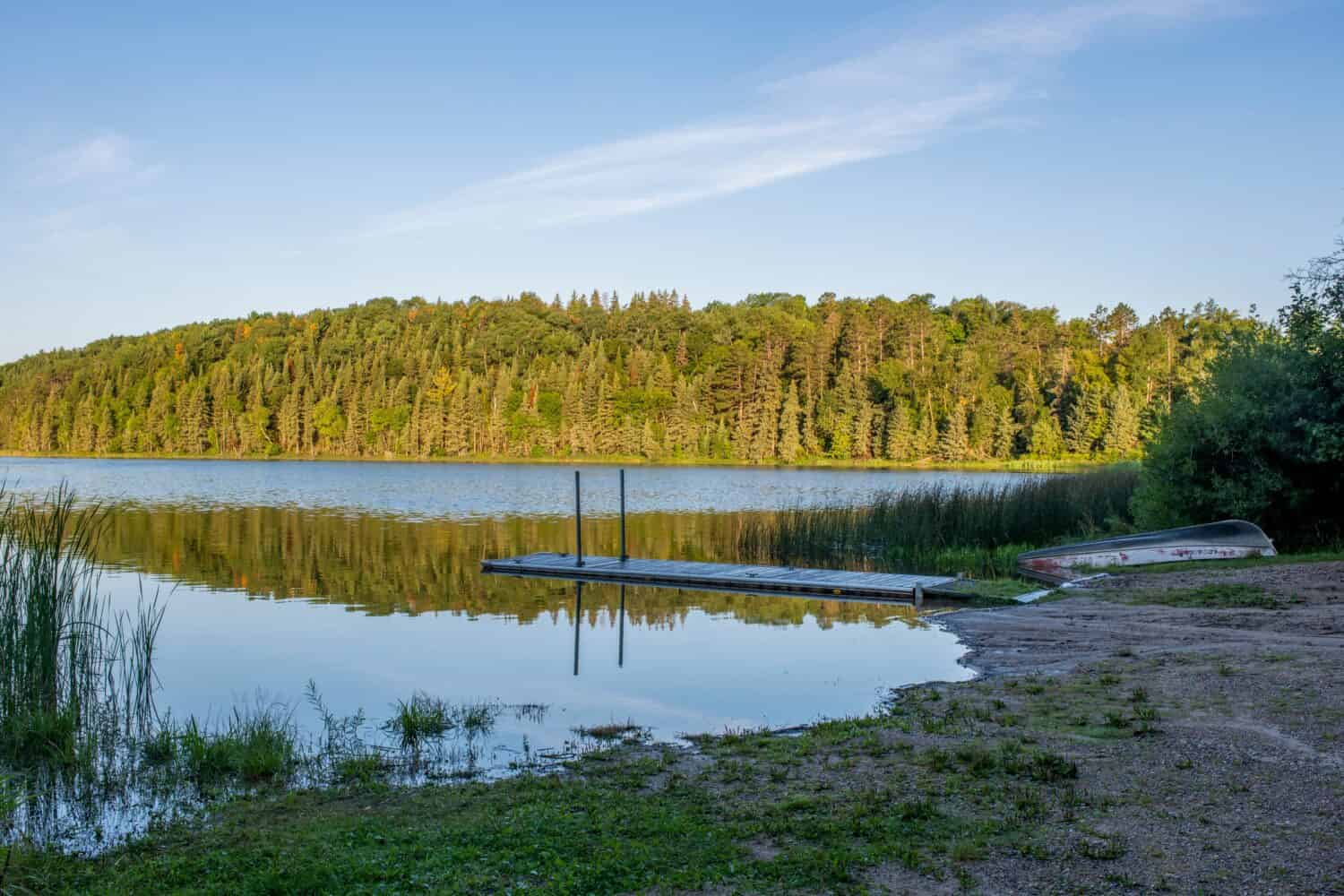
229 miles northeast of Minneapolis, La Salle Lake has a maximum depth of 213 feet.
©Danita Delimont/Shutterstock.com
La Salle Lake is another lake in the northern wilderness of Minnesota. It is the deepest lake fully enclosed in the state of Minnesota. This pristine lake is located in Hubbard County, approximately 229 miles northeast of Minneapolis, by car.
With a maximum depth of 213 feet, as reported by the Minnesota Department of Natural Resources, La Salle Lake is the deepest lake that is fully enclosed in the state of Minnesota. Its clear, cold waters cover an area of only 221 acres, offering a serene escape into nature’s embrace. Moreover, this long and narrow lake has a shoreline that stretches approximately 18,600 feet.
La Salle Lake is popular among destination for outdoor enthusiasts due to its tranquil beauty and excellent fishing opportunities. Anglers frequent its waters in pursuit of a variety of fish species, such as walleye, black crappie, bluegill, northern pike, and lake trout. Its deep, cold depths provide a suitable habitat for these catches.
In recent years, the lake has been labeled a state recreation site. Furthermore, the lake and landscape surrounding it have been identified as containing “High and Outstanding Biodiversity Significance” by the Minnesota County Biological Survey (MCBS). The surrounding landscape is adorned with dense and diverse plant and animal life. It is also an ideal destination for hiking, birdwatching, and wildlife photography.
Ten Mile Lake
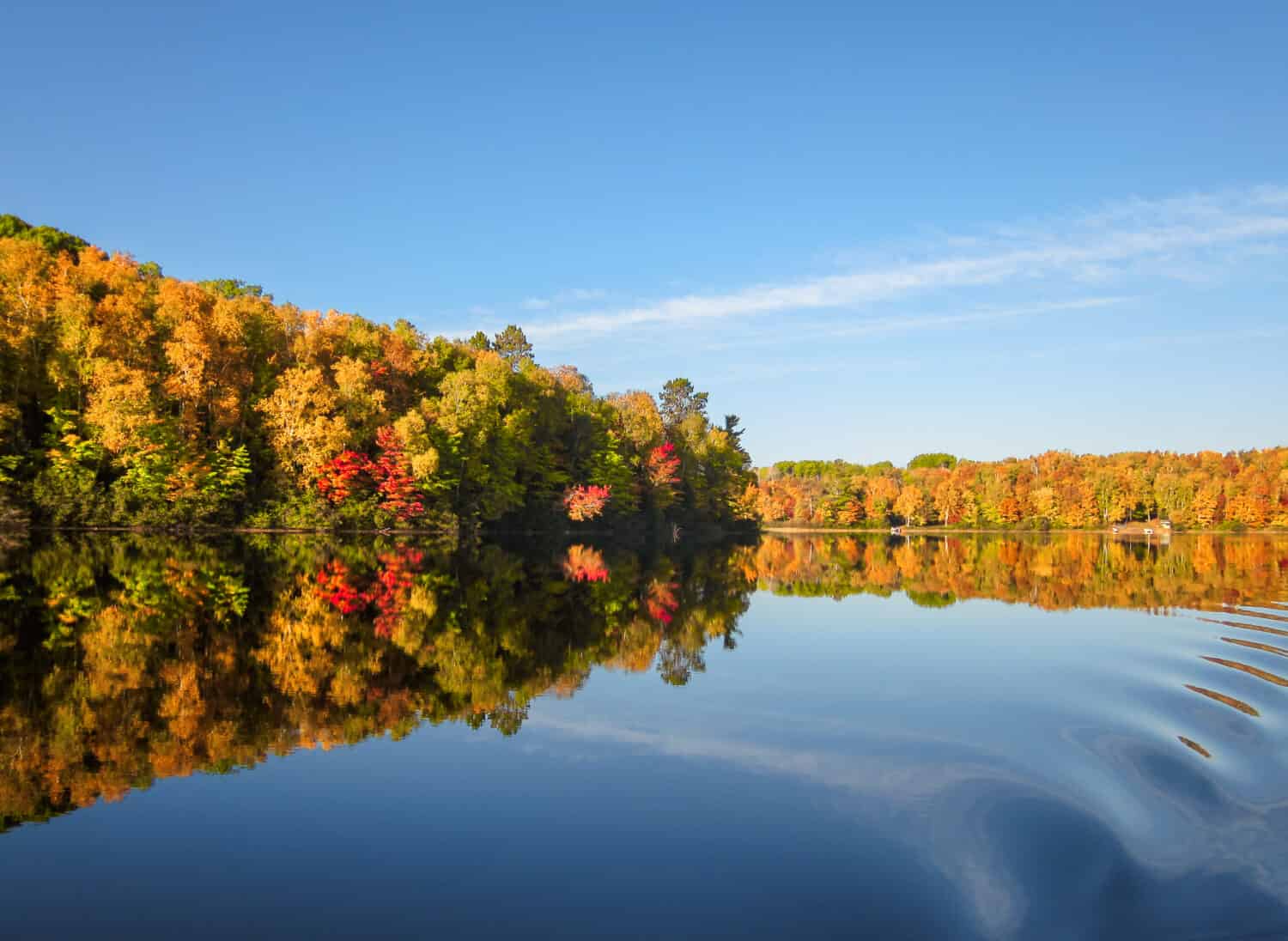
180 miles north and slightly west of Minneapolis by car, Ten Mile Lake has a maximum depth of 209 feet.
©TammiMild/Shutterstock.com
Ten Mile Lake, nestled in the northern part of the state, is a remarkable body of water with a maximum depth of 209 feet. It is situated approximately 180 miles north and slightly west of Minneapolis by car.
Furthermore, surrounded by lush forests and abundant wildlife, this picturesque lake spans 5,046 acres. It has a shore length of approximately 25 miles. Its irregular shoreline is dotted with bays and inlets, providing scenic views at every turn. The lake’s waters make it an ideal spot for swimming, boating, and water sports.
Moreover, like many lakes in Minnesota, Ten Mile Lake has exceptional fishing opportunities. Anglers can catch fish like walleye, northern pike, largemouth bass, smallmouth bass, cisco, whitefish, bluegill, black crappie, and yellow perch. The lake’s varied underwater topography provides a thrilling challenge for fishing enthusiasts.
One of the unique features of Ten Mile Lake is that it is the second-deepest natural lake that is solely within the state of Minnesota. This lake has a history of being well-documented by various entities such as the Minnesota Department of Natural Resources. This commitment to conservation ensures that the lake remains healthy and a destination for recreation for generations to come.
Loon Lake
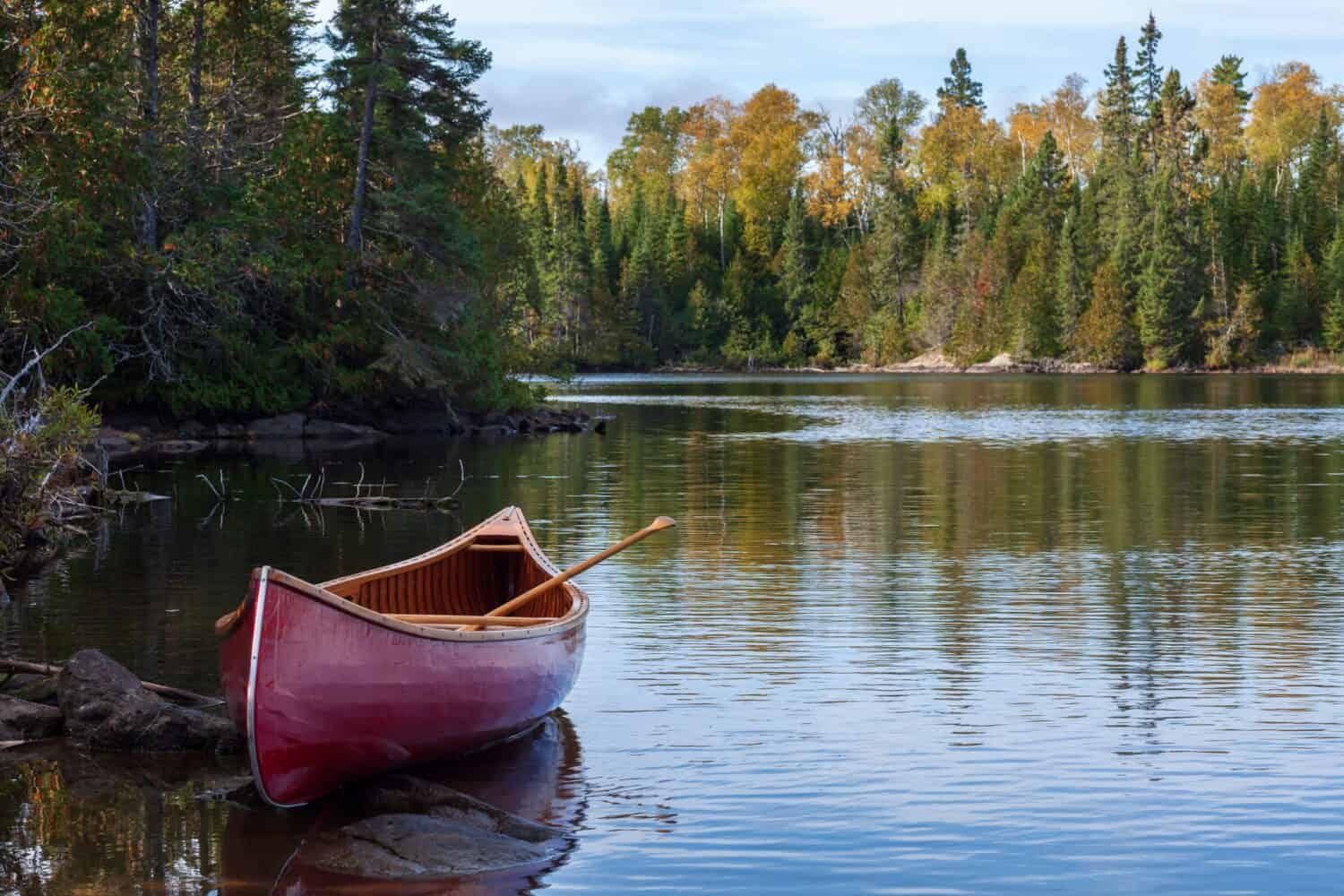
303 miles north of Minneapolis and nestled along the Gunflint Trail, Loon Lake has a maximum depth of 202 feet.
©Dan Thornberg/Shutterstock.com
Loon Lake is a pristine oasis tucked away in northeastern Minnesota on the Gunflint Trail. It offers a serene escape from the hustle and bustle of life. Located in Cook County, this picturesque lake is approximately 303 miles north of Minneapolis by car.
Furthermore, with a maximum depth of 202 feet, Loon Lake is a deep and mysterious body of water. It is a narrow lake that spans approximately 1,025 acres and stretches for about 4 miles in length, with a maximum width of around 2 miles. Its irregular shoreline is adorned with thick forests, creating a sense of seclusion and tranquility.
Moreover, Loon Lake is renowned for its fishing waters and unspoiled beauty. It is a haven for outdoor enthusiasts with its easy-to-access waters. The lake is a popular destination for kayaking and canoeing as well. Its pristine surroundings offer ample opportunities for exploration and wildlife observation.
Fishing enthusiasts are drawn to Loon Lake for its variety of fish species, including walleye, northern pike, largemouth bass, lake trout, and rock bass. Its significantly deep waters provide an ideal habitat for these sought-after species.
One of the unique features of Loon Lake is its namesake residents, the common loons. These iconic birds are a symbol of wilderness and solitude, and their haunting calls echo across the lake’s waters during the summer months. Moreover, they are the state bird of Minnesota. Observing loons in their natural habitat is a memorable experience.
Lake Carlos
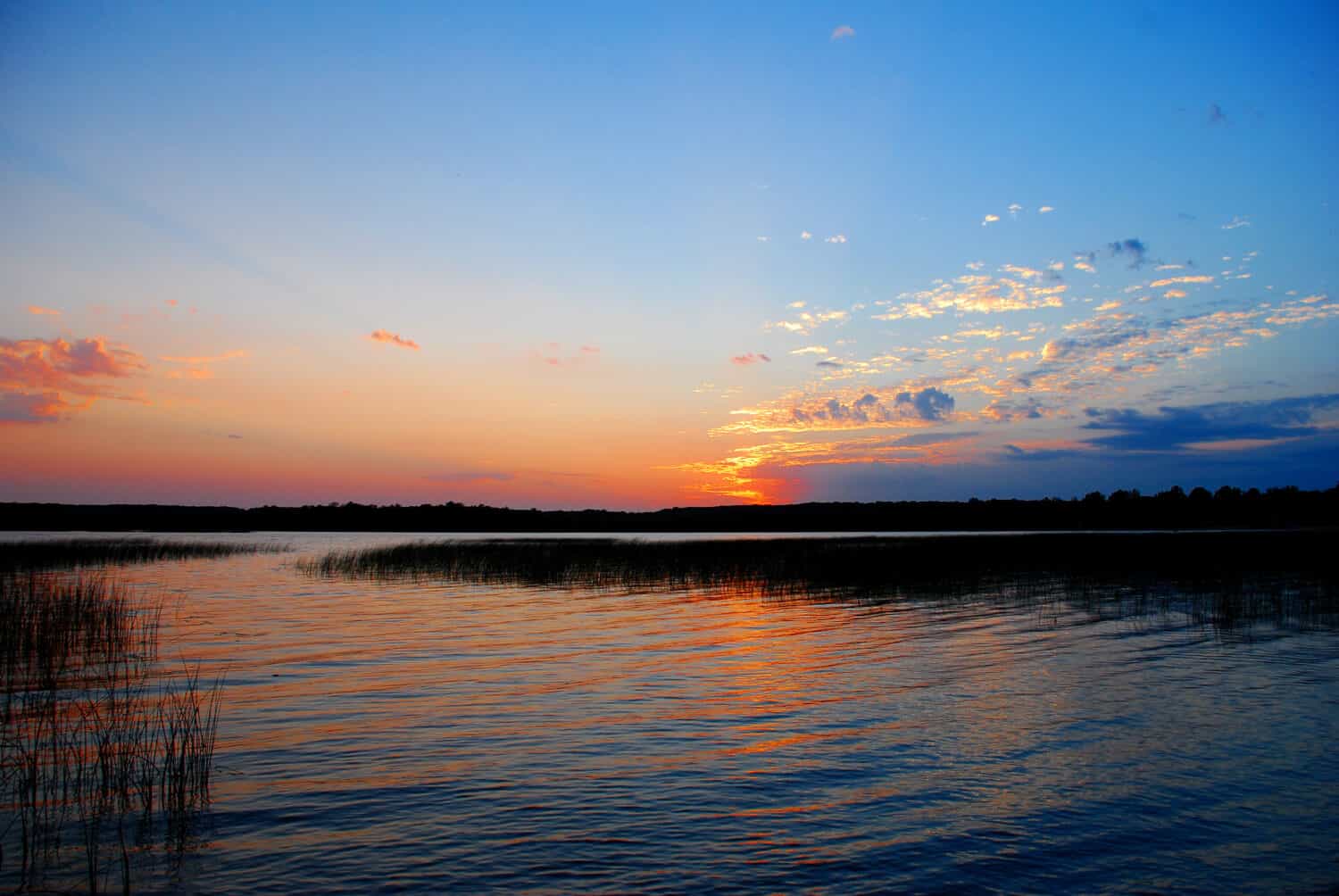
136 miles northwest of Minneapolis by car, Lake Carlos has a maximum depth of 163 feet.
©Brian A Wolf/Shutterstock.com
Lake Carlos, nestled in central Minnesota, is located in Douglas County. This deep lake is approximately 136 miles northwest of Minneapolis by car.
Lake Carlos has a maximum depth of 163 feet. It also ranks among the deepest lakes in Minnesota. Its inviting waters cover an area of around 2,605 acres, offering ample space for exploration. Moreover, the lake’s shoreline stretches around 13 miles in total.
Moreover, Lake Carlos is a favored destination for those seeking solace in nature’s embrace in this neck of the woods. The lake’s clear waters are perfect for swimming, boating, and various water sports. Its shoreline is dotted with cozy cabins and resorts, welcoming visitors to enjoy the peaceful ambiance.
Furthermore, fishing enthusiasts will find Lake Carlos a rewarding destination. The lake hosts a variety of fish species, including cisco, walleye, northern pike, and largemouth bass. Its underwater world provides an exciting challenge for anglers of all levels. Furthermore, due to its low phosphorus levels, the lake supports a large population of emergent and submerged vegetation such as chara, bladderwort, and curly-leaf pondweed.
One of the unique features of Lake Carlos is that its north shore falls within Lake Carlos State Park. There are plentiful opportunities to camp, paddle, boat, or fish. It is an inviting and comfortable lake for hikers and nature enthusiasts to explore the waters and surrounding trails.
Rainy Lake
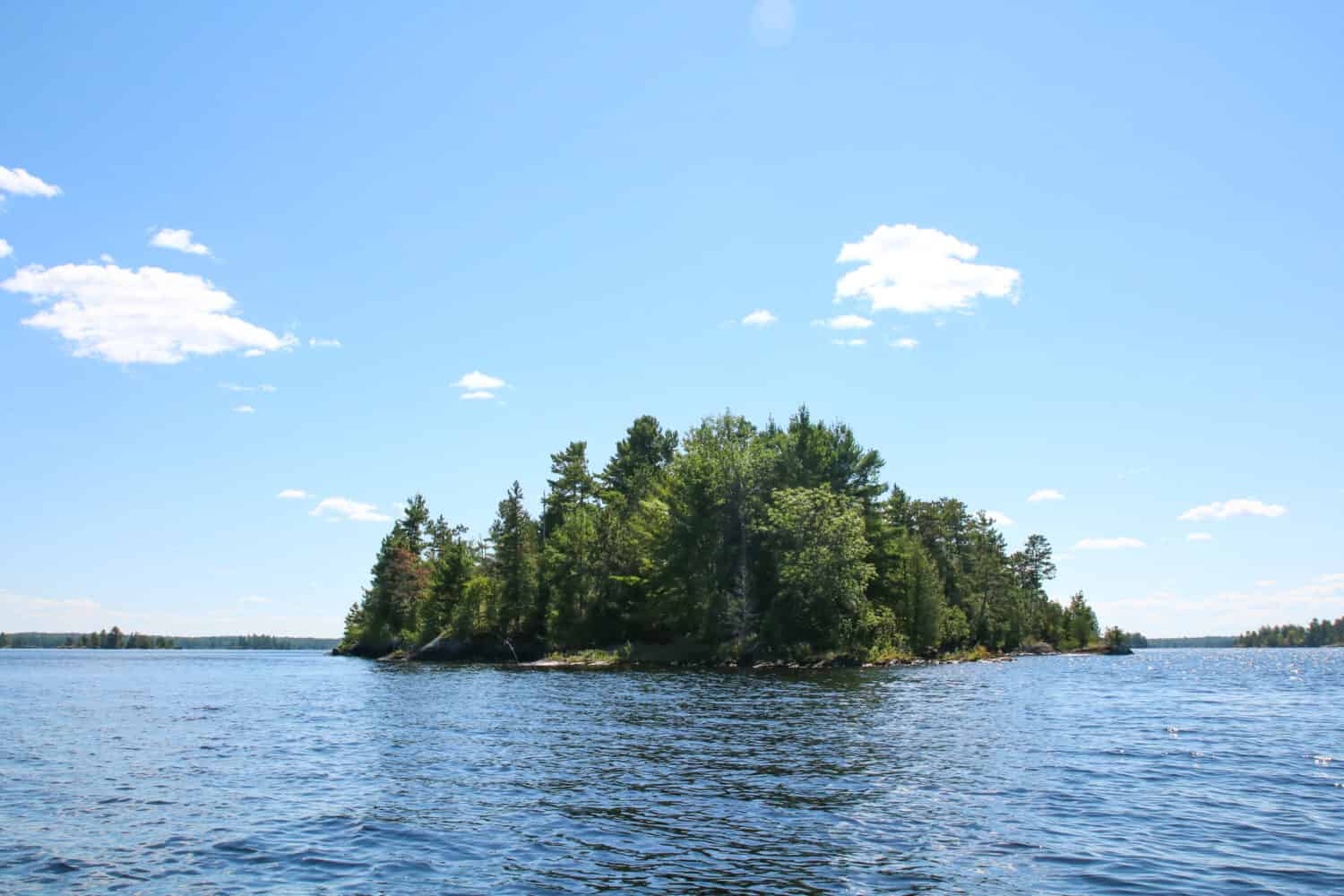
291 miles north of Minneapolis, Rainy Lake has a maximum depth of 161 feet.
©Olga Enger/Shutterstock.com
Rainy Lake is situated in the northernmost part of Minnesota on the Minnesota and Ontario borders. With a maximum depth of 161 feet, this lake holds a special place among Minnesota’s aquatic treasures. It is located approximately 291 miles north of Minneapolis, making it a remote but rewarding destination for nature enthusiasts.
Furthermore, spanning over 360 square miles, Rainy Lake is an expansive body of water with a length of about 50 miles and a maximum width of 30 miles. Its shoreline is a tapestry of rocky cliffs, sandy beaches, and lush forests.
Rainy Lake also has notable fishing opportunities. Anglers enjoy its waters in pursuit of muskellunge, walleye, largemouth bass, northern pike, and smallmouth bass. The lake’s diverse underwater ecosystem supports a thriving fish population.
Moreover, one of the unique features of Rainy Lake is its international character. It straddles the border between the United States and Canada, with Voyageurs National Park encompassing a portion of its United States shoreline. This park offers a gateway to the pristine wilderness of the area, with opportunities for boating, camping, and wildlife observation.
In the winter months, Rainy Lake transforms into a frozen wonderland, attracting ice fishermen and snowmobilers. Lastly, the lake’s ice-covered surface is a testament to the ever-changing beauty of Minnesota’s natural landscapes.
Leech Lake

Approximately 194 miles north of Minneapolis, Leech Lake has a maximum depth of 150 feet.
©Ben Harding/Shutterstock.com
Leech Lake, a prominent body of water in northern Minnesota’s landscape within the Chippewa National Forest, draws locals and visitors alike. Located in Cass County, this large and deep lake is approximately 194 miles north of Minneapolis.
Furthermore, Leech Lake is one of Minnesota’s deeper lakes, with a maximum depth of 150 feet. It encompasses an expansive surface area of about 102,948 acres with 195 miles of shoreline. Its odd shape and irregular shoreline are adorned with picturesque bays, peninsulas, and around 12 islands.
Moreover, Leech Lake is a popular destination for a wide range of outdoor activities. With its size and crystal-clear waters, it is ideal for boating, swimming, and all water sports. The lake’s diverse landscapes offer opportunities for hiking, camping, birdwatching, and wildlife observation.
Anglers are drawn to Leech Lake for its exceptional fishing opportunities. The lake is teeming with various fish species, such as walleye, bass, northern pike, perch, panfish, eelpout, and muskellunge. Moreover, it is renowned for its annual International Eelpout Festival, a unique celebration of this quirky fish.
Finally, one of the unique features of Leech Lake is Shingobee Bay. It has some of the deepest waters of the lake and is adjacent to Walker Bay.
Cass Lake

210 miles north of Minneapolis by car, Cass Lake has a maximum depth of 120 feet.
©Five1Four8/Shutterstock.com
Another deep lake in the Chippewa National Forest is Cass Lake. This picturesque lake is approximately 210 miles north of Minneapolis by car. It resides in both Cass County and Beltrami County.
With a maximum depth of 120 feet, Cass Lake is yet another deep body of water in its general area. It spans an expansive surface area of about 15,598 acres. Its shoreline is a blend of sandy beaches, rocky outcrops, and lush forests.
Furthermore, Cass Lake has clear and expansive waters that are a destination for outdoor recreation. The lake is a popular destination for boating, swimming, kayaking, and beachside activities. Its pristine surroundings offer ample opportunities for hiking, camping, or indulging in beachside resorts.
Moreover, fishing enthusiasts will find Cass Lake a rewarding destination. The lake hosts a variety of fish species. Some species include walleye, northern pike, yellow perch, muskellunge, and tullibee.
A unique feature of Cass Lake is that it is the eighth-largest lake solely located in Minnesota and the eleventh-largest lake in Minnesota. Moreover, it has five islands, including Cedar Island, Star Island, the two Potato Islands, and a small unnamed island. Star Island contains its lake by the name Lake Windigo, which has a surface area of 199 acres.
Otter Tail Lake

Approximately 188 miles northwest of Minneapolis, Otter Trail Lake has a maximum depth of 120 feet.
©Barbarajo/Shutterstock.com
Otter Tail Lake in Otter Tail County, nestled in northwestern Minnesota, is a recreational oasis that invites all to explore its beauty. It is approximately 188 miles northwest of Minneapolis by car.
Furthermore, with a maximum depth of 120 feet, Otter Tail Lake is among Minnesota’s deeper lakes. It spans an expansive surface area of about 21 square miles, offering ample space for water-based activities. Along its shoreline, you can find various resorts, campgrounds, cabins, restaurants, and more amenities, making it a popular vacation spot not too far east of Fergus Falls. Residential and commercial development surrounds the majority of its shores. However, the lake is also surrounded by a tree line of deciduous trees. In the fall, these trees burst with spectacular color and vibrancy.
This large, deep lake is ideal for fishing, swimming, boating, and water sports such as jet skiing, wakeboarding, paddleboarding, tubing, power boating, and so much more. The lake’s surrounding landscapes offer opportunities for lounging, camping, birdwatching, and enjoying the surrounding amenities and conveniences.
Moreover, there are a wide variety of fish species found in Otter Tail Lake. Some species include walleye, northern pike, muskellunge, and perch. The lake’s rich fish population provides an exciting challenge for anglers of all levels.
One of the unique features of Otter Tail Lake is its connection to the Otter Tail River, which flows through it. This connection highlights the lake’s role in Minnesota’s waterways and ecosystems. Furthermore, as a lake that is solely within the boundaries of Minnesota, it is the tenth-largest lake in the state.
List of Some of the Deepest Lakes in Minnesota
| Rank | Lake | Maximum Depth |
|---|---|---|
| 1 | Lake Superior | 1,332 feet |
| 2 | Lake Saganaga | 280 feet |
| 3 | La Salle Lake | 213 feet |
| 4 | Ten Mile | 209 feet |
| 5 | Loon Lake | 202 feet |
| 6 | Carlos Lake | 163 feet |
| 7 | Rainy Lake | 161 feet |
| 8 | Leech Lake | 150 feet |
| 9 | Cass Lake | 120 feet |
| 10 | Otter Tail Lake | 120 feet |
Conclusion
Minnesota, the land of 10,00 lakes, is home to diverse and captivating landscapes with some of the deepest and most enchanting lakes in the region. These natural bodies of water, many with crystal-clear waters, rich aquatic ecosystems, and unique features, invite locals and visitors to explore and appreciate their pristine beauty and abundance of recreational activities.
At approximately 1,332 feet deep, Lake Superior, the largest of them all, stands as a symbol of natural grandeur as the deepest lake in Minnesota. It boats colossal dimensions and spans across national and international borders. The lake’s rugged shoreline and vibrant culture add to its appeal.
Furthermore, Leech Lake and Loon Lake, with their vast expanses and clear waters, offer genuine wilderness experiences within the boundaries of Minnesota. Cass Lake resides among sandy beaches and lush forests and beckons with its serene ambiance and connection to the Leech Lake Chain of Lakes. In the northwestern part of the state, Otter Tail Lake charms those who visit for its convenience, ample surrounding amenities, abundant fish populations, and vast recreational opportunities. Moreover, Lake Saganaga, La Salle Lake, Ten Mile Lake, Carlos Lake, and Rainy Lake each boast unique features with considerably deep depths.
These lakes are bodies of water with thriving ecosystems. Furthermore, they are all cherished recreational spots and vital contributors to the state’s natural heritage. They remind us of the need to preserve and protect these aquatic treasures for generations to come.
The photo featured at the top of this post is © Five1Four8/Shutterstock.com
Thank you for reading! Have some feedback for us? Contact the AZ Animals editorial team.






